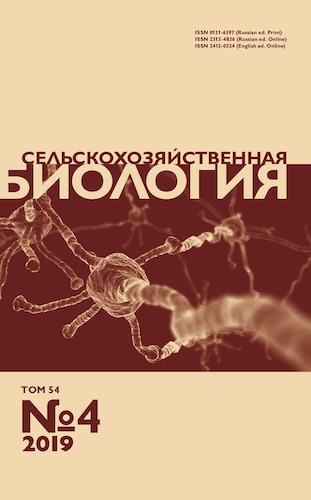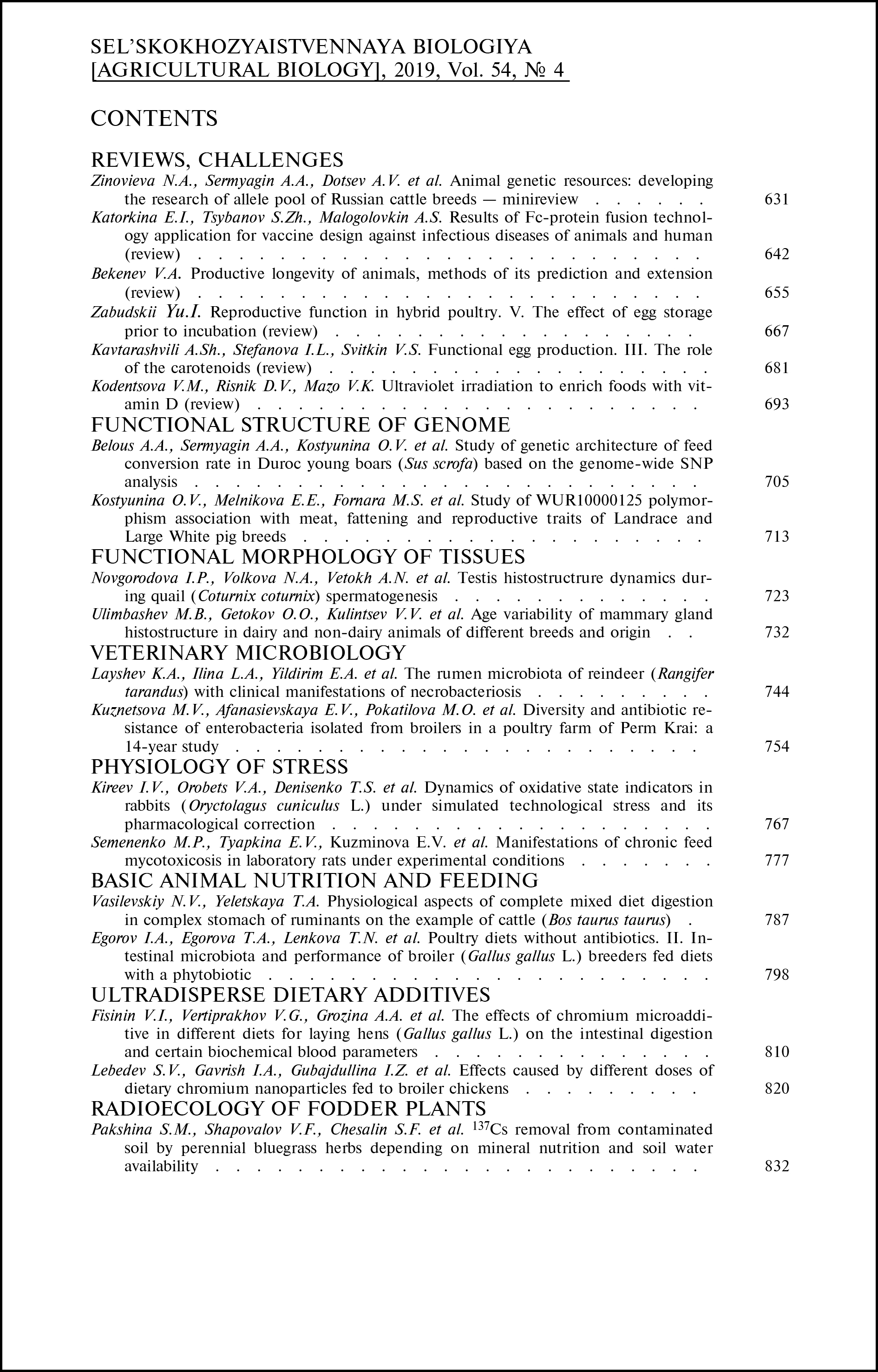doi: 10.15389/agrobiology.2019.4.723eng
UDC: 636.5:591.463.12:591.8.086.2
Acknowledgements:
Supported financially by Russian Science Foundation, grant No. 16-16-04104
TESTIS HISTOSTRUCTRURE DYNAMICS DURING QUAIL (Coturnix coturnix) SPERMATOGENESIS
I.P. Novgorodova, N.A. Volkova, A.N. Vetokh, L.A. Volkova,
V.A. Bagirov, N.A. Zinovieva
Ernst Federal Science Center for Animal Husbandry, 60, pos. Dubrovitsy, Podolsk District, Moscow Province, 142132 Russia, e-mail novg-inna2005@yandex.ru (✉ corresponding author), natavolkova@inbox.ru,
anastezuya@mail.ru, ludavolkova@inbox.ru, vugarbagirov@mail.ru, n_zinovieva@mail.ru
ORCID:
Novgorodova I.P. orcid.org/0000-0002-4617-1644
Volkova L.A. orcid.org/0000-0002-9407-3686
Volkova N.A. orcid.org/0000-0001-7191-3550
Bagirov V.A. orcid.org/0000-0001-8385-2433
Vetokh A.N. orcid.org/0000-0002-2865-5960
Zinovieva N.A. orcid.org/0000-0003-4017-6863
Received December 5, 2018
Male sex cells are unique objects for scientific research in the field of genetics and physiology and in the study of the development biological basis in animal husbandry. Maturation and differentiation processes in male animals and birds germ cells are of great interest for comparative embryology, developmental biology, medicine and biotechnology. Quails characterized by early puberty and a short generation period are perspective for these experimental works. The greatest interest is the use of spermatogonia, the testes stem cells which are currently being actively studied as promising targets for the introduction of recombinant DNA in obtaining transgenic individuals. However, the morphology of germ cells from male poultry in their formation process is not fully covered. For the first time, we describe in detail the histological features of spermatogenical quail epithelium tissue at different stages of spermatogenesis and the dynamics of spermatogonial testis cells populations in this study. The aim of the study was to identify age-related features of spermatogenesis associated with the dynamics of the different cell type development in the epithelial spermatogenous layer of the seminiferous tubules in quail. For this, we examined the histological structure of the testes in quail (Coturnix coturnix) of the Estonian breed at the age of 1, 2, 3, 4, 5, 6, 12, and 24 weeks. In each age group, there were 10 males. Testis tissue was fixed in Bouins’s solution, dehydrated in alcohols of increasing concentration and embedded in paraffin. Five to six micron histological sections were stained with hematoxylin-eosin. The composition of spermatogenic cells and their ratio in the seminiferous tubules was investigated. At least 30 seminiferous tubules were examined from each male. The diameter of the seminiferous tubules in the quail testes changed during ontogenesis and at the age of 1, 2, 3, 4, 5, 6, 12 and 24 weeks reaching 42±1, 71±2, 91±2, 117±2, 237±4, 278±5, 28 ±7 and 291±6 µm, respectively. Sertoli cells and generative cells were parts of cell population of the quail seminiferous tubules at different stages of differentiation, i.e. spermatogonia, spermatocytes, spermatids and sperm cell maturation. The number of spermatogenic cells inside the seminiferous tubules increased with age (p < 0.01) and was 18±1, 24±1, 58±4, 80±6, 249±16, 587±34, 658±24 and 540±41 in quails aged 1, 2, 3, 4, 5, 6, 12 and 24 weeks, respectively. In 1-week aged quails, Sertoli cells dominate in seminiferous tubules (12±1 per seminiferous tubule) while spermatogonia are few, 1 to 4 cells per tubule. The number of spermatogonia increases with age. The percentage of spermatogonia is maximum in 3-week aged birds, 76±2 % of the total number of spermatogenic cells. In 4-week aged quails, primary and secondary spermatocytes are visualized in the seminiferous tubules, and from week 5 spermatids are found. At the age of 5 weeks, we detected single spermatozoa, the number of which increased in the quail semen tubules by the 6-week age. Thus, the quails’ age from 1 to 3 weeks is optimal for manipulating spermatogonia as targets for introducing recombinant DNA in order to obtain transgenic offspring or biological material to preserve the genetic resources of farm birds in cryobanks.
Keywords: quail, testes, Sertoli cells, spermatogenesis, spermatogonia.
REFERENCES
- Olive V., Cuzin F. The spermatogonial stem cell: from basic knowledge to transgenic technology. The International Journal of Biochemistry & Cell Biology, 2005, 37: 246-250 CrossRef
- Takashima S. Biology and manipulation technologies of male germline stem cells in mammals. Reproductive Medicine and Biology, 2018, 17(4): 398-406 CrossRef
- Sofikitis N., Kaponis A., Mio Y., Makredimas D., Giannakis D., Yamamoto Y., Kanakas N., Kawamura H., Georgiou J., Schrader M., Lolis E., Giannakopoulos X., Loutradis D., Tarlatzis V., Miyagawa I. Germ cell transplantation: a review and progress report on ICSI from spermatozoa generated in xenogeneic testes. Human Reproduction Update, 2003, 9(3): 291-307 CrossRef
- Dobrinski I., Avarbock M.R., Brinster R.L. Germ cell transplantation from large domestic animals into mouse testes. Molecular Reproduction and Development, 2000, 57: 270-279 CrossRef
- Brinster R.L. Germline stem cell transplantation and transgenesis. Science, 2002, 296: 2174-2176 CrossRef
- Honaramooz A.1., Megee S.O., Dobrinski I. Germ cell transplantation in pigs. Biology of Reproduction, 2002, 66(1): 21-28 CrossRef
- Savchenkova I.P., Korjikova S.V., Kostereva N.V., Ernst L.K. Cultivation and transfer of porcine type A spermatogonia. Russian Journal of Developmental Biology, 2006, 37(4): 242-249 CrossRef
- Rodriguez-Sosa J.R., Dobson H., Hahnel A. Isolation and transplantation of spermatogonia in sheep. Theriogenology, 2006, 66: 2091-2103 CrossRef
- Yu F., Ding L.J., Sun G.B., Sun P.X., He X.H., Ni L.G., Li B.C. Transgenic sperm produced by electrotransfection and allogeneic transplantation of chicken fetal spermatogonial stem cells. Molecular Reproduction and Development, 2010, 77: 340-347 CrossRef
- Li B., Sun G., Sun H., Xu Q., Gao B., Zhou G., Zhau W., Wu X., Bao W., Yu F., Wang K., Chen G. Efficient generation of transgenic chickens using the SSCs in vivo and ex vivo transfection. Science China Life Sciences, 2008, 51: 734-742 CrossRef
- Zheng Y., Zhang Y., Qu R., He Y., Tian X., Zeng W. Spermatogonial stem cells from domestic animals: progress and prospects. Reproduction, 2014, 147: 65-74 CrossRef
- Nakamura Y., Usui F., Miyahara D., Mori T., Ono T., Takeda K., Nirasawa K., Kagami H., Tagami T. Efficient system for preservation and regeneration of genetic resources in chicken: concurrent storage of primordial germ cells and live animals from early embryos of a rare indigenous fowl (Gifujidori). Reproduction Fertility Devevelopment, 2010, 22: 1237-1246 CrossRef
- Deviche P., Hurley L.L., Fokidis H.B. Function, avian testicular structure and regulation. In: Hormones and Reproduction of Vertebrates. D. Norris, K. H. Lopez (eds.). Elsevier Inc., 2011: 27-70 CrossRef
- Wei L., Peng K.-M., Liu H., Song H., Wang Y., Tang L. Histological examination of testicular cell development and apoptosis in the ostrich chick. Turkish Journal of Veterinary and Animal Sciences, 2011, 35(1): 7-14 CrossRef
- Thurston R.J., Korn N. Spermiogenesis in commercial poultry species: anatomy and control. Poultry Science, 2000, 79: 1650-1668 CrossRef
- Aire T.A., Ozegbe P.C. The testicular capsule and peritubular tissue of birds: morphometry, histology, ultrastructure and immunohistochemistry. Journal of Anatomy, 2007, 210: 731-740 CrossRef
- Jamieson B.G.M. Avian spermatozoa: structure and phylogeny. In: Reproductive Biology and Phylogeny of Birds. B.G.M. Jamieson (ed.). Science Publishers, Enfield, New Hampshire, U.S.A. Jersey, Plymouth, U.K., 2007: 349-511.
- Peruquetti R.L., Taboga S.R., Vilela de Azeredo-Oliveira M.T. Morphological changes of mammalian nucleoli during spermatogenesis and their possible role in the chromatoid body assembling. International Scholarly Research Notices. Cell Biology, 2012, 2012: Article ID 829854 CrossRef
- Endovitskaya I.P., Zinov'eva N.A., Ernst L.K. Tsitologiya, 2005, 47(1): 44-48 (in Russ.).
- Beloglazova E.V., Kotova T.O., Volkova N.A., Volkova L.A., Zinov'eva N.A., Ernst L.K. Age dynamics of spermatogenesis in cocks in connection with optimization of bioengineering manipulation time. Sel'skokhozyaistvennaya biologiya [Agricultural Biology], 2011, 6: 60-64 (in Engl.).
- Volkova N.A., Vetokh A.N., Novgorodova I.P., Dotsev A.V., Zinovieva N.A. The dynamics of spermatogenesis in guinea fowls. Reproduction, Fertility and Development, 2017, 30(1): 211-211 CrossRef
- Abdul-Rahman I., Obese F.Y., Robinson J.E. Spermatogenesis and cellular associations in the seminiferous epithelium of Guinea cock (Numida meleagris). Canadian Journal of Animal Science, 2017, 97(2): 241-249 CrossRef
- Aire T.A. Spermatogenesis in birds. Spermatogenesis, 2014, 4(3): e959392 CrossRef
- Savel'eva A.Yu. Mezhdunarodnyi nauchno-issledovatel'skii zhurnal, 2016, 4(46): 59-62 CrossRef
- Kannan T.A., Ramesh G., Sivakumar M. Age related changes in the gross and histoarchitecture of testis in Japanese quails (Coturnix coturnix japonica). International Journal of Livestock Research, 2015, 5(6): 26-33 CrossRef
- Bausova K.V. Ptitsevodstvo, 2016, 8: 48-52 (in Russ.).
- Kouatcho F.D., Kenfack A., Ngoula F., Teguia A. Sexual maturity prediction based on hormonal profiles, testes and semen characteristics in male Coturnix quail (Garsault, 1764) in the Western Highlands of Cameroon. International Journal of Agronomy and Agricultural Research (IJAAR), 2015, 7(4): 143-154.
- Bello U.M., Madekurozwa M.-C., Groenewald H.B., Aire T.A., Arukwe A. The effects on steroidogenesis and histopathology of adult male Japanese quails (Coturnix coturnix japonica) testis following pre-pubertal exposure to di(n-butyl) phthalate (DBP). Comparative Biochemistry and Physiology Part C: Toxicology & Pharmacology, 2014, 166: 24-33 CrossRef
- Hussain R., Khan A., Mahmood F., Rehan S., Ali F. Clinico-hematological and tissue changes induced by butachlor in male Japanese quail (Coturnix japonica). Pesticide Biochemistry and Physiology, 2014, 109: 58-63 CrossRef
- Türk G., Simsek U.G., Çeribasi A.O., Çeribasi S., Kaya S.O., Güvenç M., Çiftçi M., Sönmez M., Yüce A., Bayrakdar A., Yaman M., Tonbak F. Effect of cinnamon (Cinnamomum zeylanicum) bark oil on heat stress-induced changes in sperm production, testicular lipid peroxidation, testicular apoptosis, and androgenic receptor density in developing Japanese quails. Theriogenology, 2015, 84: 365-376 CrossRef
- Yadav S., Chaturved C.M. Light colour and intensity alters reproductive/seasonal responses in Japanese quail. Physiology & Behavior, 2015, 147: 163-168 CrossRef












